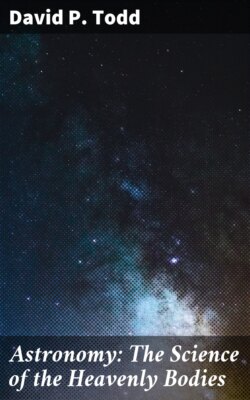Читать книгу Astronomy: The Science of the Heavenly Bodies - David P. Todd - Страница 8
На сайте Литреса книга снята с продажи.
CHAPTER IV
ORIGIN OF GREEK ASTRONOMY
ОглавлениеTable of Contents
While the Greeks laid the foundations of modern scientific astronomy, they were not as a whole observers: rather philosophers, we should say. The later representatives of the Greek School, however, saw the necessity of observation as a basis of true induction; and they discovered that real progress was not possible unless their speculative ideas were sufficiently developed and made definite by the aid of geometry, so that they became capable of detailed comparison with observation. This was the necessary and ultimate test with them, and the same is true to-day. The early Greek philosophers were, however, mainly interested, not in observations, but in guessing the causes of phenomena.
Thales of Miletus, founder of the Ionian School, introduced the system of Egyptian astronomy into Greece, about the end of the seventh century B. C. He is universally known as the first astronomer who ever predicted a total eclipse of the sun that happened when he said it would: the eclipse of B. C. 585. This he did by means of the Chaldean eclipse cycle of 18 years known as the Saros.
Aristarchus of Samos was the first and most eminent of the Alexandrian astronomers, and his treatise "On the Magnitudes and Distances of the Sun and Moon" is still extant. This method of ascertaining how many times farther the sun is than the moon is very simple, and geometrically exact. Unfortunately it is impossible, even to-day, to observe with accuracy the precise time when the moon "quarters," (an observation essential to his method), because the moon's terminal, or line between day and night, is not a straight line as required by theory, but a jagged one. By his observation, the sun was only twenty times farther away than the moon, a distance which we know to be nearly twenty times too small.
His views regarding other astronomical questions were right, although they found little favor among contemporaries. Not only was the earth spherical, he said, but it rotated on its axis and also traveled round the sun. Aristarchus was, indeed, the true originator of the modern doctrine of motions in the solar system, and not Copernicus, seventeen centuries later; but Seleucus appears to have been his only follower in these very advanced conceptions. Aristarchus made out the apparent diameters of sun and moon as practically equal to one another, and inferred correctly that their real diameters are in proportion to their distances from the earth. Also he estimated, from observations during an eclipse of the moon, that the moon's diameter is about one-third that of the earth. Aristarchus appears to have been one of the clearest and most accurate thinkers among the ancient astronomers; even his views concerning the distances of the stars were in accord with the fact that they are immeasurably distant as compared with the distances of the sun, moon, and planets.
Practically contemporary with Aristarchus were Timocharis and Aristillus, who were excellent observers, and left records of position of sun and planets which were exceedingly useful to their successors, Hipparchus and Ptolemy in particular. Indeed their observations of star positions were such that, in a way, they deserve the fame of having made the first catalogue, rather than Hipparchus, to whom is universally accorded that honor.
Spherical astronomy had its origin with the Alexandrian school, many famous geometers, and in particular Euclid, pointing the way. Spherics, or the doctrine of the sphere, was the subject of numerous treatises, and the foundations were securely laid for that department of astronomical research which was absolutely essential to farther advance. The artisans of that day began to build rude mechanical adaptations of the geometric conceptions as concrete constructions in wood and metal, and it became the epoch of the origin of astrolabes and armillary spheres.
